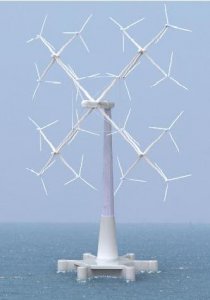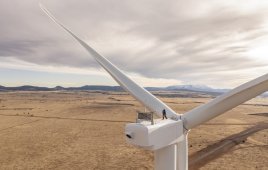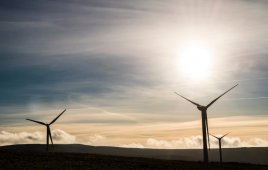The largest wind turbine so far is a German giant with a 126-m diameter rotor. Everything about it is huge. Even the 29-m tower foundation requires some 120 tons of steel. Such designs have become difficult and expensive to manufacture, ship, install, and maintain.

Greenward’s Quad Array puts four smaller turbines on arms to capture as much energy as a 100-m diameter conventional unit. In addition, the cross arms rotates but only to position each turbine close to the tower for easier service than conventional turbines would allow.
“The most commonly used basis of comparison is the Specific Total Generating Head Mass,” says Ed Salter, CTO and cofounder of Greenward Technologies, Austin, Texas. ”This is the combined mass of the nacelle and rotor divided by the rotor disk area. It has gone from a low of about 18 kg/m2 for the most cost-effective 2 MW class turbine to over 50 kg/m2 for a 5-MW turbine. This means nearly three times as much material goes into creating each kilowatt hour. Claims of increased efficiency pale in comparison to this major up-trend in specific mass.” Another bad omen is the difficulty involved in shipping and installing these machines, and “mass production” is generally constrained to several turbines per month. Is there a better way?
Salter thinks so. Since the 1970’s, several researchers have advocated an idea of using the most cost-effective turbine size in multi-rotor arrays, but no one had a workable design. In late 2007, Salter says he devised a way to use four mid-sized, counter rotating modular wind turbines that feature proven lightweight flexible rotors mounted on a streamlined “X” frame that rotates for servicing. He calls them Quad Arrays. The approach provides benefits that address most all of the manufacturing, distribution, installation, reliability, and O & M issues that the industry is currently facing, and reduces all major components of the cost-of-energy equation by 30 to 50%. Salter has built a working 1-m scale model to test what he calls the Wake Convergence and Swirl Cancellation Hypothesis.
Another big plus for the design: it needs no crane for removal and replacement of modular turbines thanks to a patent-pending robotic forklift and a depot-level service strategy. This, he says, will open the wind-turbine O & M field to technicians who would otherwise have to spend days abused by environmental extremes on 300-ft towers, and it will greatly extend the careers of those who are currently employed in this field.

Greenward CTO Ed Salter says the 16-unit array could generate up to 20 MW.
Salter admits the concept of multi-rotor arrays is not new, but nothing has reached production. He says his Wind Turbine Quad Array will change that, as it has been designed from the ground up to provide solutions for all barriers to mass production.
Economic goals for the design
Greenward’s Salter says new turbine thinking should meet these specs:
- Specific mass of the individual modular turbines must be reduced to less than 60% of the best of current technology. Otherwise, the design just adds more cost with the array frame and mechanism, and the resulting design would not be competitive. Also, the structure of the array frame must be more material-intensive to support the added weight of the conventional turbines. The only way to achieve this level of reduction in specific mass is through the use of lightweight, flexible turbine technology combined with modular turbine design.
- Reliability. The mean time between failure (MTBF) of individual modular turbines must increase substantially for the system MTBF to increase. A few ways to hit such a target include a modular design and large reduction of part counts, and a large reduction in operating loads. This is accomplished through the use of lightweight, flexible composite rotor blades. Lastly, there must be redundancy in critical areas.
- For O&M considerations, there must be a provision for servicing, removing, and replacing individual turbine modules in a short period. This has been lacking in systems that have been proposed up to now, but is the cornerstone of Greenward’s turbine tower.
- And regarding controls: the system must be designed for this application and not just carried over from conventional turbines. The controls must also include a way for dealing with wind shear to null out bending loads on the yaw bearing.

A rare aerial photo of an offshore windfarm in Denmark shows how turbulence generated by large turbine rotors builds with each successive row of turbines. CFD studies show that Greenwards counterrotating blades do not generate the turbulence of conventional designs. A video on the company's websites shows more.
Filed Under: Turbines




